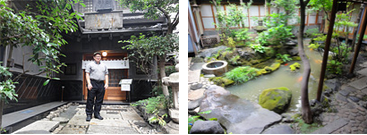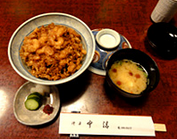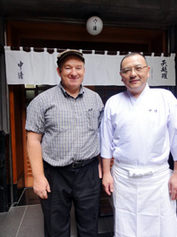 |
セインさん。今日うかがうのは、浅草寺のすぐ近くにある老舗の天ぷら屋さん「中清」です。幕末の創業で、ご主人の中川敬規さんが6代目を継いでおられます。
Thayne-san, today we’ll visit a famous old tempura shop close to Asakusa Temple called Nakasei. It was established during the Tokugawa Shogunate and has been handed down six generations to the current owner, Takanori Nakagawa. |
|
|
 |
天ぷらは、大好き。楽しみです!
Tempura is my favorite. This will be fun! |
|
|
| (中川) |
ようこそ、セインさん。中川です。
Welcome, Thayne-san. My name is Nakagawa. |
|
|
 |
こんにちは。中川さん、はじめまして! お店に入るまでのエントランスも情緒たっぷりで、素敵なお店ですね。
Hello. Nice to meet you, Nakagawa-san. Your shop has great atmosphere, starting with the entrance. It’s wonderful. |
|
|
| (中川) |
ありがとうございます。道から少し引っ込んで建っているので、ちょっと落ち着いた雰囲気になっています。中庭もご覧になってください。
Thank you. It’s built back from the street, so it’s a little more peaceful. Let me show you the courtyard. |
|
|
 |
ワーォ。すごい。池に鯉も泳いでいるんですね。大観光地の真ん中にあるのに、ここは別世界のように、日本の景色があるんですね。
Wow. It’s amazing. There are carp in the pond. Although you’re in the middle of a huge sightseeing spot, it’s like another world here, like a view of Japan. |
|
|
| (中川) |
庭を囲むように離れ座敷をつくっているんです。
We have some separate rooms centered around the garden. |
|
|
 |
有名な作家、永井荷風などが贔屓にしたのも、味とともに、この静かなたたずまいが気に入られたのでしょうね。今は、おしのびで来られる有名人カップルも多いそうですよ。
Famous authors like Kafu Nagai were regular customers here. They were fond of the food and peaceful atmosphere. I heard some celebrity couples come here in secret. |
|
|
 |
はい。それから、お見合いやご法事にもよくお使いいただいています。
Yes. The shop is often used for marriage arrangements and memorial services as well. |
|
|
 |
この店でお見合いしたら、きっとうまくいきますね。
Meeting your future spouse here seems like a sure bet. |
|
|
|
 |
|
|
 |
ところで、この店の天ぷらの特徴は何ですか?
So what’s different about the tempura here? |
|
|
| (中川) |
まず、天ぷらの材料は魚介類だけだということ。野菜は使わないんです。そして、江戸風で、胡麻油で揚げているということです。天つゆの味つけも、関西に比べると少し甘辛です。
First off, we only use seafood. We don’t use vegetables. We deep-fry the tempura Edo-style in sesame oil. Compared to Kansai, the tempura sauce’s flavor is a little sweeter and saltier. |
|
|
 |
そのスタイルは、創業からずっと同じですか。
Has that style been the same since the shop was founded? |
|
|
| (中川) |
創業当時は屋台の店ですから、おもてなしの形は違いますが、揚げ方などは140年余、変わっていません。
The shop was originally a food cart, so the service was different. But the way our tempura is deep-fried hasn’t changed in over 140 years. |
|
|
 |
すごいですね。そうすると、中川さんも、小さい頃から、この店を継ぐように言われて育ったんですか?
That’s impressive. So, Nakagawa-san, were you raised being told you would take over the shop? |
|
|
| (中川) |
いえ、それはありませんでした。次男だったということもあってのんびり育ったのと、私が大学へ行っている時に父が急に亡くなったので、跡継ぎについてもその時にバタバタっと決まったんです。ですから天ぷらの揚げ方なども、長く店にいた経験豊富な板前さんに一から教えてもらいました。
No, I wasn’t. I was the second son and grew up carefree. But my father suddenly passed away when I was in college, and in the confusion it was decided I would take over the shop. So I learned tempura frying from square one with a chef who had been at the shop a long time and had a lot of experience. |
|
|
 |
そうなんですか。中川さんの跡継ぎさんは、もう決まっているんですか?
Oh, I see. Do you know who your successor will be? |
|
|
| (中川) |
はい。いまは他店で修業しているところです。 天ぷらの作り方は、うちで教えられるんですが、外の世界を経験することが大事だろうと思って。ほかのお店のやり方を見せていただくことが、いろいろな意味で、いつか役にたつだろうと。
Yes, he’s currently working at another restaurant. I could teach my son how to make tempura here, but I think it’s important to experience the outside world. It may also be useful someday to have seen how other shops function. |
|
|
 |
他の店のやり方を見て、そちらがいい!と思ってしまったりはしないんでしょうか。
But I doubt your successor will look at another shop’s methods and say, “I want to do it their way!” |
|
|
| (中川) |
若い頃は、いろいろ考えるでしょうね。私も、若い頃は、代々受け継いできた料理にこだわるやり方に反発しましたよ。いろいろな料理を作りたいと思いましたし、こうすればもっとよくなると考えたり……。先祖が残してくれたものの本当の価値がわかってきたのは、年をとってからです(笑)。
Young people have a lot of thoughts. When I was young, I didn’t want to fuss over following a generations-old recipe. I wanted to make many kinds of foods and thought, Oh, it might be better if I do this… I didn’t understand the value of receiving something handed down from my ancestors until I was older (laughs). |
|
|
 |
なるほど。深い話ですね。
I see. That’s has a lot of meaning. |
|
|
 |
ところで、浅草といえば三社祭。中川さんも、1年が祭りで始まり、祭りで終わる浅草っ子だと思うのですが。
By the way, Asakusa is famous for the Sanja Festival. I heard you’re an Asakusa-ko (person born and raised in Asakusa), so the year for you begins and ends with that festival, I suppose. |
|
|
| (中川) |
はい。もちろん。 いい年になりましたから、もうお神輿は担ぎませんが、イベントとしての三社祭ではなく、神事を執行するという立場で関わっています。子 どもの頃から浅草でお神輿をかついできた人間ですから、この街で生まれ育ち、住んでいる者の使命だと思って参加させていただいています。
Yes. Definitely! I’m getting on in age, so although I can’t carry the portable shrines anymore, I’m involved in the Sanja Festival as a religious practice rather than as an event. I’ve carried the shrines in Asakusa since I was a child, so I participate and think of it as a responsibility for people who were born and raised here. |
|
|
 |
江戸っ子、浅草っ子は、熱いですね。
Edo-ko (people born and raised in Tokyo) and Asakusa-ko are passionate. |
|
|
| (中川) |
人のつながりを大切にしているんです。三社祭だけじゃなくて、夏休みには「子ども会」を催し、冬には「火の用心」と言いながら、街を歩きます。1年を通して、そういうことをいろいろやりながら、街の人間関係が濃くなっていく。それが、祭りにもつながっているんです。
I really value human connections. It’s not only the Sanja Festival―we also hold a children events during the summer vacation, and in the winter we walk around town warning people to be careful with fire. Doing things like that throughout the year deepens human relations. That’s also connected us to the festivals. |
|
|
 |
僕は根津に住んでいて、地元のお祭りでは神輿を担いだことがあるんですが、三社祭も近くで見てみたいです。
I live in Nezu, and I’ve carried the shrine at local festivals, but I’d like to see Sanja Festival up close as well. |
|
|
| (中川) |
どうぞ、どうぞ。来年はうちの法被を着て、ぜひお神輿を担いでください。
By all means, please do. Please wear our happi coat next year and carry the shrine. |
|
|
  |
嬉しい。では、来年! 今日は、ありがとうございました!
That sounds like a lot of fun! See you next year! Thanks for everything today. |
|
 椅子席で味わえる「かき揚げ丼」。 椅子席で味わえる「かき揚げ丼」。
芝エビとアオヤギの貝柱の大きなかき揚げがのっている。
A seafood fritter rice bowl can be enjoyed while seated. It’s a large fritter with prawns and Aoyagi muscles. |
|
 |
|
(文)太田美代 (英訳)デイビッド・A・セイン |
 1959年、米国生まれ。証券会社勤務を経て来日し、翻訳・通訳など多岐にわたって活躍。豊富な教授経験を生かし、数多くの英語関係書籍を執筆。近著に『日本人のチョットへんな英語』(アスコム)、『超入門シャドーイング』(主婦の友社)、日本人が使いすぎる英語(PHP文庫)など多数。
1959年、米国生まれ。証券会社勤務を経て来日し、翻訳・通訳など多岐にわたって活躍。豊富な教授経験を生かし、数多くの英語関係書籍を執筆。近著に『日本人のチョットへんな英語』(アスコム)、『超入門シャドーイング』(主婦の友社)、日本人が使いすぎる英語(PHP文庫)など多数。









